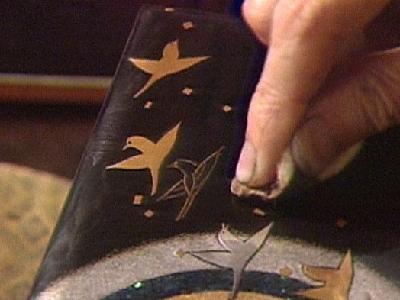|
Makie, a lacquer working technique, is a traditional craftwork passed down through generations for over 1,500 years.
While other lacquer techniques such as “Hyoumon” and “Raden” originated in China, the oldest evidence of Makie lacquer was discovered inside Shousouin Temple. It is believed the Makie technique is indigenous to Japan and is unique in the world.
The word “makie” come from “maki” meaning “sprinkle” and “e” meaning “painting”.
In the makie technique, patterns and pictures are drawn on to lacquer ware with lacquer, and while they are still wet, gold and silver metal powders are sprinkled on to designs adhering to the wet lacquer.
Any excess powder protruding from the drawings and remaining unattached to the surface are later brushed off, thus allowing beautiful patterns to finally emerge.
Makie is further divided by its techniques: Tokidashi Makie, Hira Makie, Taka Makie, Shishiai Makie, Rankaku Makie among others. The technique of “shading off” by a way of sprinkling the powder is also used. Makie is an art form with a wide variety of expressions.
The fact that metal powders are not pasted, but “sprinkled” might give some insight into the Japanese characteristic of being finely tuned to details.
While other lacquer techniques such as “Hyoumon” and “Raden” originated in China, the oldest evidence of Makie lacquer was discovered inside Shousouin Temple. It is believed the Makie technique is indigenous to Japan and is unique in the world.
The word “makie” come from “maki” meaning “sprinkle” and “e” meaning “painting”.
In the makie technique, patterns and pictures are drawn on to lacquer ware with lacquer, and while they are still wet, gold and silver metal powders are sprinkled on to designs adhering to the wet lacquer.
Any excess powder protruding from the drawings and remaining unattached to the surface are later brushed off, thus allowing beautiful patterns to finally emerge.
Makie is further divided by its techniques: Tokidashi Makie, Hira Makie, Taka Makie, Shishiai Makie, Rankaku Makie among others. The technique of “shading off” by a way of sprinkling the powder is also used. Makie is an art form with a wide variety of expressions.
The fact that metal powders are not pasted, but “sprinkled” might give some insight into the Japanese characteristic of being finely tuned to details.
| [+ADDRESS] | 
|













